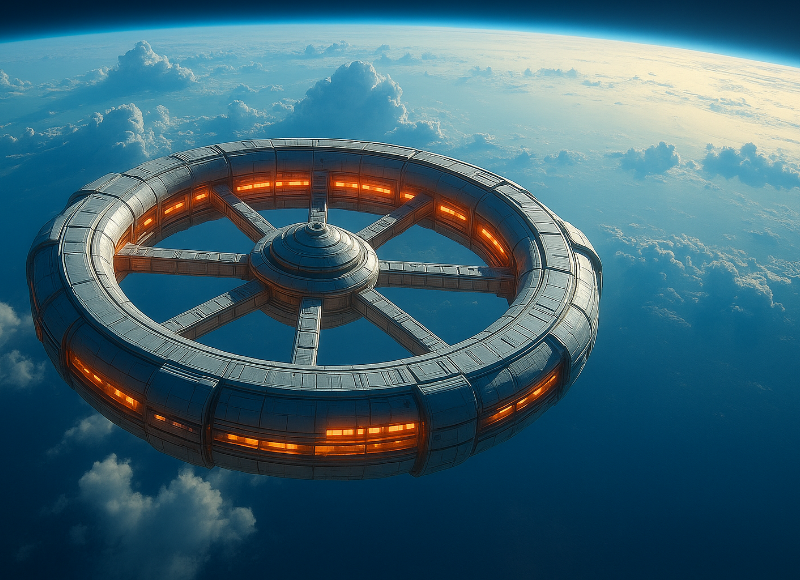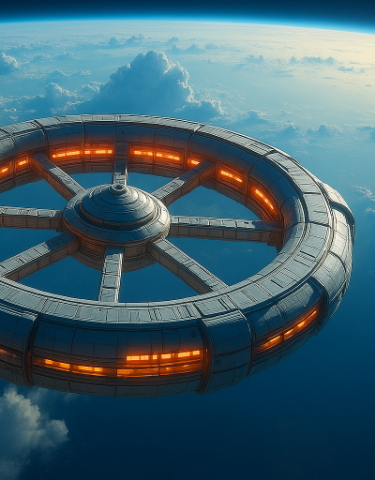A villa with a view of the whole world
Imagine sipping champagne while the Earth spins slowly outside your panoramic window. Below you: continents, clouds, and storms the size of small countries. Inside: a gleaming hotel suite, gravity just strong enough to keep your drink from floating away, and a menu offering everything from sushi to zero-G chocolate fondue.
That’s the Voyager Station promise — a rotating wheel-shaped space hotel that its creators say will deliver luxury amenities in orbit: restaurants, gyms, concert halls, and even villas for the ultra-wealthy traveller.
But behind the dazzling concept art lies a labyrinth of risks that even seasoned aerospace veterans admit will be hard to navigate. For investors, travellers, regulators, and dreamers alike, understanding these risks isn’t just about safety — it’s about whether the entire business can get off the launchpad.
Welcome to the most glamorous high-risk venture of our time.
Exploring Voyager Station’s risks — many of which have no precedent in hospitality history
- Strategic Risks — Could the project fail to meet its long-term goals?
- Operational Risks — Could things break, fail, or go wrong in day-to-day running?
- Financial Risks — Can the project be funded, and can it stay solvent?
- Compliance & Legal Risks — Are all the laws and safety standards being followed?
- Reputational Risks — Could an accident or bad press sink public trust?
- Strategic Risks – Mission Drift: When Your Orbit Doesn’t Match Your Trajectory
The grand vision for Voyager Station hinges on multiple moving targets: securing billions in funding, booking heavy-lift launch vehicles, assembling massive rotating structures in space, and doing it all before competitors steal the limelight.
Key strategic risks:
- Timeline credibility — The 2027 opening date has been touted in press releases. No construction has begun, and funding commitments aren’t public.
- Competition — Companies are pursuing smaller, more achievable stations sooner. If they prove viable first, Voyager might lose its “first in luxury space tourism” branding.
- Market adoption — Will enough wealthy customers pay millions for the first trips? Or will the market hesitate until prices fall — potentially decades later?
Strategic risk here is about overpromising and under delivering. A missed launch window could cascade into lost investor confidence, brand damage, and eventual project abandonment. Hence, strategic risk management is extremely crucial.
- Operational Risks – No Room Service in Orbit: The Perils of Running a Hotel 400km Up
Running a hotel in orbit makes running one in the middle of the Antarctic look like a picnic. In space, you can’t call the plumber or run to the grocery store — every spare part, every lettuce leaf, every screw has to be launched and stored.
Operational risk management includes managing risks associated with:
- Life-support systems — Oxygen, water recycling, waste management, and temperature control must work flawlessly for hundreds of people.
- Station integrity — Micrometeoroids traveling faster than bullets could puncture the hull. Even small leaks demand immediate, precise response.
- Emergency evacuation — If a fire, depressurization, or medical emergency occurs, getting guests to Earth could take hours — and only if enough functioning spacecraft are docked.
- Supply chain in space — Miss a scheduled resupply launch, and guests might be eating ration packs instead of gourmet meals.
Redundancy, preventive maintenance, and continuous monitoring are non-negotiable. In space, operational risk is amplified by isolation — there’s no safety net.
- Financial Risks – The Billion-Dollar Balance Beam
Space hotels aren’t just expensive; they’re the definition of capital-intensive. Construction, launch, and operations could run into the multi-billions, with ticket sales only a drop in the bucket at first.
Financial risks:
- Upfront capital — Investors must commit billions before a single guest checks in.
- Revenue uncertainty — With early ticket prices possibly in the $3M–$50M range, demand could be small and unpredictable.
- Cost overruns — In aerospace, projects routinely exceed budgets by 50%–100% (or more).
- Dependency on external providers — Launch costs depend on third parties (SpaceX, Blue Origin, etc.). Delays or price hikes could destabilize the business case.
Without a sustainable revenue model, the hotel could become a “white elephant” in orbit — an impressive but financially unsupportable achievement. This can be avoided by practicing financial risk management.
- Compliance & Legal Risks – Whose Laws Apply Above the Clouds?
Space law is still a patchwork of international treaties, national regulations, and emerging commercial standards.
Ambiguity with regard to :
- Jurisdiction — If a crime happens aboard Voyager, whose laws apply? The flag of the registry? The nationality of the perpetrator?
- Insurance — Underwriting is new territory. Premiums could be astronomical (pun intended).
- Environmental impact — How will orbital debris and launch emissions be regulated?
Compliance risk here is also reputational — one high-profile legal incident could scare off customers and investors. Thus, risk management in space is of grave importance.
- Reputational Risks – One Bad Headline, and Your Brand Falls Out of Orbit
In the hospitality industry, reputation is everything. In space tourism, it’s life or death for the brand.
Potential reputational risks:
- Accidents — Even a minor incident could be magnified by the media as a “luxury space hotel nightmare.”
- Delays — Multiple missed deadlines could turn the project into a running joke.
- Elitism backlash — The optics of billionaires vacationing in space while Earth faces crises could spark criticism.
Transparency and realistic communication are vital. Overhyping or hiding setbacks will erode trust.
- The Unique Space-Specific Risks
Beyond standard ERM categories, space introduces some exotic, almost sci-fi challenges:
- Radiation storms — Solar flares can bombard stations with harmful radiation, requiring safe rooms with extra shielding.
- Orbital debris collisions — Even tiny fragments can cause catastrophic damage. The station will need collision-avoidance systems.
- Gravity transitions — Moving between rotating gravity zones and zero-G could cause accidents, spills, or disorientation.
- Artificial gravity side effects — Voyager’s rotating ring will simulate lunar-to-partial Earth gravity. But spinning habitats can induce motion sickness, disorientation, and long-term vestibular effects.
- Psychological strain — Guests may experience anxiety or claustrophobia in a confined, high-risk environment.
- Medical emergencies without immediate hospitals — Even with a doctor on board, major surgeries may be impossible until evacuation.
Enterprise Risk Management: The Framework for a Space Hotel
ERM is about identifying, assessing, and managing risks in a structured way. Think of it as the captain’s dashboard for decision-making. If Voyager Station is to succeed, it needs a rigorous, transparent enterprise risk management framework:
- Risk Identification – Identify all plausible risks, not just the likely ones.
By cataloguing even highly improbable but potentially catastrophic risks (so-called black swans), leaders avoid blind spots. This ensures no material threat is excluded at the outset.
- Voyager Station must map all risks, from financing crises to orbital collisions.
- Risk Assessment & Prioritization – Prioritize those with the highest impact, even if low probability.
Once risks are identified, organizations assess likelihood and impact. Traditional methods give undue weight to “most likely” risks, but an advanced ERM approach considers consequences first. This shifts focus toward resilience against existential threats, not just routine problems.
- Life-support and safety should top Voyager station’s list.
- Risk Response / Mitigation Strategy – Build in redundancy — every critical system should have a backup (and a backup for the backup).
The risk mitigation phase emphasizes layered resilience. Critical systems should not hinge on a single point of failure. By investing in “backups for the backup” and risk mitigation strategies, organizations avoid disruptions from unforeseen shocks.
- Voyager station must include redundancy in systems, finance and launch logistics.
- Risk Monitoring & Preparedness – Train staff for rapid, decisive crisis response.
A plan is only as strong as the people implementing it. Regular training ensures teams can quickly recognize a risk event, escalate appropriately, and take decisive action, minimizing paralysis during high-pressure situations.
- Voyager Station can incorporate risk monitoring through scenario drills, tabletop exercises, and crisis simulations for staff.
- Governance, Compliance & Regulatory Engagement – Engage regulators early to define clear, consistent standards.
ERM embeds proactive engagement into governance. This helps shape practical compliance requirements, anticipate regulatory shifts, and reduce the chance of punitive surprises. It also builds trust and credibility, ensuring smoother relationships during crises or audits.
- Voyager Station must establish early, proactive partnerships.
- Stakeholder Communication & Reporting – Communicate with investors, media, and the public
Transparency is the final key piece of risk governance. By offering clear, timely updates and articulating not only successes but also acknowledging vulnerabilities and setbacks, organizations foster trust and protect reputation. A disciplined communication plan ensures stakeholders know risks are actively managed and that leadership is accountable.
- Voyager Station should maintain transparency with backers and the public to build confidence.
Past Missions, Present Warnings: What Apollo 13 and the International Space Station Can Teach Voyager
- Apollo 13 (1970) — An oxygen tank explosion derailed a Moon mission, but redundancy, creative problem-solving, and teamwork brought the crew home.
- Columbia Disaster (2003) — Launch damage to the shuttle’s heat shield led to disaster during re-entry, showing that risks exist at every stage.
- International Space Station Air Leak (2018) — A 2 mm puncture caused a slow pressure drop; quick patching by astronauts averted danger.
These moments remind us that for Voyager Station, small problems can escalate fast. History’s lessons and the implementation of space tourism safety procedures are the best insurance against them.
The Big Question: Would You Go?
Space hotels such as the Voyager Station promise the trip of a lifetime. At the same time, they tread a fine line between cutting-edge engineering and high-risk gambling on technology, funding, regulations, and safety culture.
Risk management in the hospitality industry is the need of the hour. If ERM becomes as integral to Voyager Station as its artificial gravity system, then sipping a cocktail while orbiting Earth might become just another line on the global luxury travel menu. Until then, the world will be watching — and learning — how to manage risk at 27,000 km/h.















